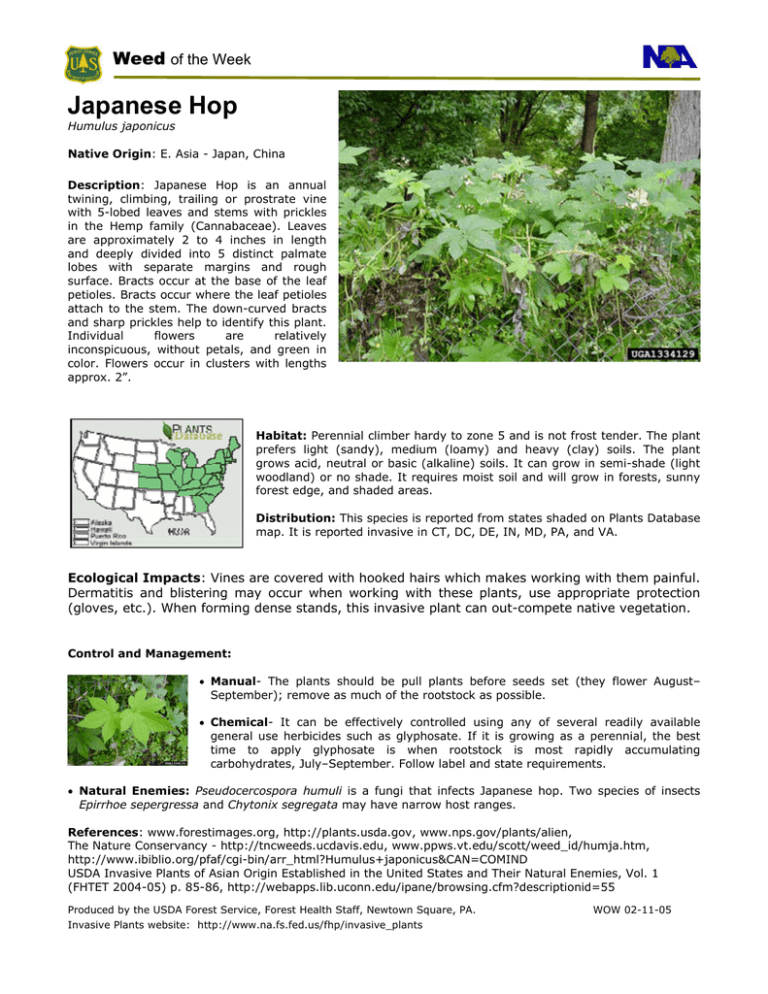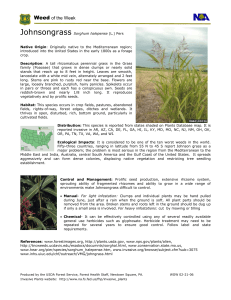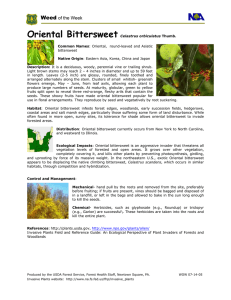Japanese Hop Weed of the Week
advertisement

Weed of the Week Japanese Hop Humulus japonicus Native Origin: E. Asia - Japan, China Description: Japanese Hop is an annual twining, climbing, trailing or prostrate vine with 5-lobed leaves and stems with prickles in the Hemp family (Cannabaceae). Leaves are approximately 2 to 4 inches in length and deeply divided into 5 distinct palmate lobes with separate margins and rough surface. Bracts occur at the base of the leaf petioles. Bracts occur where the leaf petioles attach to the stem. The down-curved bracts and sharp prickles help to identify this plant. Individual flowers are relatively inconspicuous, without petals, and green in color. Flowers occur in clusters with lengths approx. 2”. Habitat: Perennial climber hardy to zone 5 and is not frost tender. The plant prefers light (sandy), medium (loamy) and heavy (clay) soils. The plant grows acid, neutral or basic (alkaline) soils. It can grow in semi-shade (light woodland) or no shade. It requires moist soil and will grow in forests, sunny forest edge, and shaded areas. Distribution: This species is reported from states shaded on Plants Database map. It is reported invasive in CT, DC, DE, IN, MD, PA, and VA. Ecological Impacts: Vines are covered with hooked hairs which makes working with them painful. Dermatitis and blistering may occur when working with these plants, use appropriate protection (gloves, etc.). When forming dense stands, this invasive plant can out-compete native vegetation. Control and Management: • Manual- The plants should be pull plants before seeds set (they flower August– September); remove as much of the rootstock as possible. • Chemical- It can be effectively controlled using any of several readily available general use herbicides such as glyphosate. If it is growing as a perennial, the best time to apply glyphosate is when rootstock is most rapidly accumulating carbohydrates, July–September. Follow label and state requirements. • Natural Enemies: Pseudocercospora humuli is a fungi that infects Japanese hop. Two species of insects Epirrhoe sepergressa and Chytonix segregata may have narrow host ranges. References: www.forestimages.org, http://plants.usda.gov, www.nps.gov/plants/alien, The Nature Conservancy - http://tncweeds.ucdavis.edu, www.ppws.vt.edu/scott/weed_id/humja.htm, http://www.ibiblio.org/pfaf/cgi-bin/arr_html?Humulus+japonicus&CAN=COMIND USDA Invasive Plants of Asian Origin Established in the United States and Their Natural Enemies, Vol. 1 (FHTET 2004-05) p. 85-86, http://webapps.lib.uconn.edu/ipane/browsing.cfm?descriptionid=55 Produced by the USDA Forest Service, Forest Health Staff, Newtown Square, PA. Invasive Plants website: http://www.na.fs.fed.us/fhp/invasive_plants WOW 02-11-05 Weed of the Week Produced by the USDA Forest Service, Forest Health Staff, Newtown Square, PA. Invasive Plants website: http://www.na.fs.fed.us/fhp/invasive_plants




